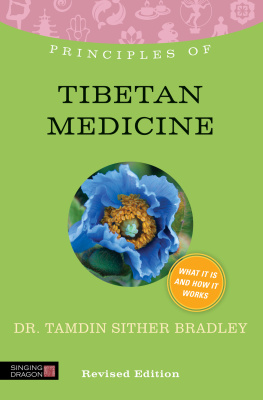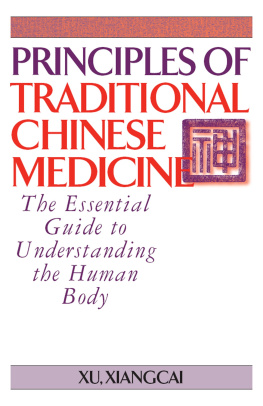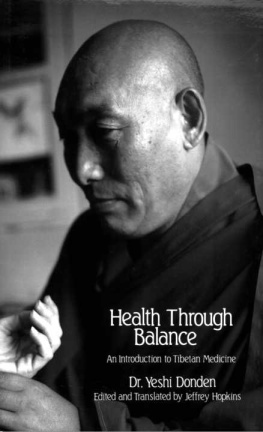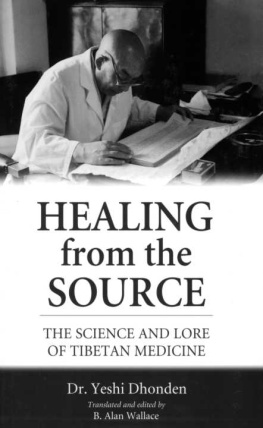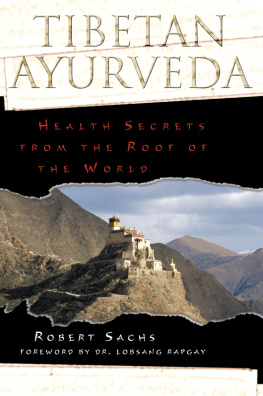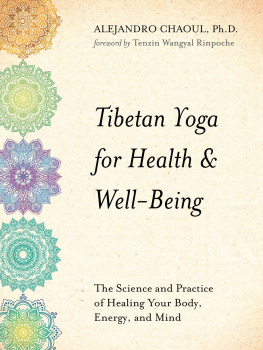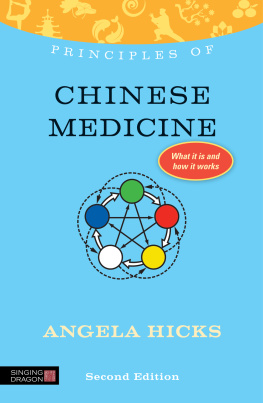
PRINCIPLES OF TIBETAN MEDICINE
other titles in the series
PRINCIPLES OF
THE ALEXANDER TECHNIQUE
Jeremy Chance
PRINCIPLES OF
BACH FLOWER REMEDIES
Stefan Ball
PRINCIPLES OF
CHINESE HERBAL MEDICINE
John Hicks
PRINCIPLES OF
CHINESE MEDICINE
Angela Hicks
PRINCIPLES OF
THE ENNEAGRAM
Karen A. Webb
PRINCIPLES OF
HYPNOTHERAPY
Vera Peiffer
PRINCIPLES OF
KINESIOLOGY
Maggie La Tourelle with Anthea Courtenay
PRINCIPLES OF
NLP
Joseph OConnor and Ian McDermott
PRINCIPLES OF
REFLEXOLOGY
Nicola Hall
PRINCIPLES OF
REIKI
Kajsa Krishni Borng
PRINCIPLES OF
TIBETAN
MEDICINE
What it is, how it works, and what it can do for you
Revised Edition
Dr. Tamdin Sither Bradley

LONDON AND PHILADELPHIA
This edition published in 2013
by Singing Dragon
an imprint of Jessica Kingsley Publishers
116 Pentonville Road
London N1 9JB, UK
and
400 Market Street, Suite 400
Philadelphia, PA 19106, USA
www.singingdragon.com
First edition published in 2000 by Thorsons, an imprint of HarperCollins
Copyright Dr.. Tamdin Sither Bradley 2000, 2013
Front cover image source: Photograph by Hedwig Storch
All rights reserved. No part of this publication may be reproduced in any material form (including photocopying or storing it in any medium by electronic means and whether or not transiently or incidentally to some other use of this publication) without the written permission of the copyright owner except in accordance with the provisions of the Copyright, Designs and Patents Act 1988 or under the terms of a licence issued by the Copyright Licensing Agency Ltd, Saffron House, 610 Kirby Street, London EC1N 8TS. Applications for the copyright owners written permission to reproduce any part of this publication should be addressed to the publisher.
Warning: The doing of an unauthorised act in relation to a copyright work may result in both a civil claim for damages and criminal prosecution.
Library of Congress Cataloging in Publication Data
Bradley, Tamdin Sither.
[Thorsons principles of Tibetan medicine]
Principles of Tibetan medicine / Dr. Tamdin Sither Bradley.
pages cm
Revision of authors: Thorsons principles of Tibetan medicine, 2000.
ISBN 978-1-84819-134-1 (alk. paper)
1. Medicine, Tibetan. I. Title.
R603.T5B73 2013
610.9515--dc23
2012040246
British Library Cataloguing in Publication Data
A CIP catalogue record for this book is available from the British Library
ISBN 978 1 84819 134 1
eISBN 978 0 85701 114 5
This book is dedicated to all my patients and to my late father, Namkha Gyaltsen, whose generosity, dignity and beautiful smile will remain with me forever
ACKNOWLEDGEMENTS
My sincere thanks to the Tibetan Medical and Astrological Institute for giving me the opportunity to study Tibetan medicine. To all my teachers of past and present for guiding me to the right path the late Professor Bashi Phuntsok Wangyal, the late Dr.. Tenzin Choedrak, Dr.. Pasang Yonten Arya, the late Dr. Lobsang Chophel, the late Dr. Kunga Gyurmey Nyarongsher, Gen. Gendhun Jinpa, Gen. Dorjee Gyalpo and the late Gen. Nyima Tsering.
To all my friends and colleagues through the years who have helped to promote Tibetan medicine. To Mr Tseten Samdup from Office of Tibet, Switzerland.
To all the editorial staff at Singing Dragon for their help and assistance. To my family for their support and encouragement. To my husband Philip for his assistance and his perseverance which enabled me to finish everything on time.
Lastly to my greatest inspiration, my uncle, the monk Gen. Tsultrim Sangpo, without whose guidance I would never have been a physician.
AUTHORS NOTE
This book is intended to be an introduction to Tibetan medicine and it is based on the Four Medical Tantras. I have put every effort to make it as accurate and informative as possible, and if there are any inaccuracies please do not hesitate to contact me. The book contains many pharmaceutical formulae, however they are for informative purposes and not for self-help use.
History of Tibetan Medicine
Methods for keeping healthy and promoting longevity have been present in Tibet for many thousands of years. For example, Tibetans know that drinking hot water will relieve indigestion and placing old melted butter in cuts and wounds will stop bleeding and promote healing.
Tibetan medicine is a traditional system of medicine which has been practised for over 2500 years. Tibetan medicine originates from the pre-Buddhist Bon era of Tibetan history. During this time there was extensive medical knowledge in Tibet and medical study was based on the four Bon medical texts known as gSo-rig Bhoom-Shi . This period in Tibetan medical history lasted from sixth century BC to seventh century AD.
However, in the seventh century changes were brought about and the influence of other medical systems became incorporated into Tibetan medical knowledge. During the reign of King Songsten Gampo the first international conference on Tibetan medicine was held in Samye in Tibet. Songsten Gampo invited to this conference many physicians from neighbouring countries such as Persia, India and China. In the eighth century, during the reign of King Trisong Detsen, Buddhism replaced Bon as the state religion of Tibet. This led to the suppression of Bon religion, culture and medical knowledge in Tibet.
In 762 Yuthog Yongten Gonpo, the court physician to Trisong Detsen, established the first Tibetan medical college in Tibet in Kongpo, the valley of medicine. Here he systematized the gSo-rig Bhoom-Shi into the nine wordings in a single sentence and replaced the old Bon titles and conclusions with Buddhist ones. During this time he added medical knowledge from neighbouring countries such as India and China. His work is the basis for the rGyud-bzhi the four Tibetan medical tantras.
There are many books which state that Tibetan medical knowledge is solely derived from India and China. This is not true as Tibet has had its own medical knowledge for thousands of years and it is important to remember that the Bon and Buddhist eras comprise two different historical periods of Tibet.
In the twelfth century Yuthog the Younger further researched and edited the rGyud-bzhi . This version has remained to this day the standard and most authoritative of Tibetan medical texts. It continues to be studied and practised by Tibetan physicians.
In the fifteenth century the Tibetan medical system divided itself into two main schools, the Jangpa and the Zurpa . In the seventeenth century the Fifth Dalai Lama was a great patron of Tibetan medicine, and his regent, Sangye Gyamtso, was a great Tibetan physician and scholar who wrote the commentary on the Four Medical Tantras, which is known as the Blue Beryl. In 1696 the Chagpori College of Medicine was founded by the Fifth Dalai Lama. In 1916 the Thirteenth Dalai Lama founded the Men-Tsee-Kang School of Medicine and Astrology in Lhasa, Tibet.
After the Tibetan uprising in 1959 Tibetans went into exile in India and in 1961, under the initiative of His Holiness the Fourteenth Dalai Lama, the Tibetan Government in Exile established the Tibetan Medical Centre in Dharamsala, India. This was built up by the hard work of doctors such as Dr. Yeshi Dhonden and the late Dr. Jamyang Tashi Tsona, both of whom were physicians to His Holiness. Since 1982 Tibetan medicine has expanded greatly due to the late Dr. Tenzin Choedak (the senior physician to His Holiness the Dalai Lama) coming to India from Tibet and bringing with him a vast and profound Tibetan medical knowledge, especially with regard to Tibetan pharmaceutical formulae.
Next page
